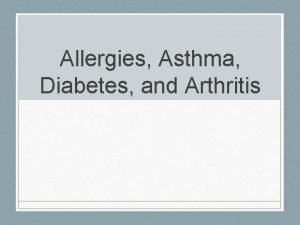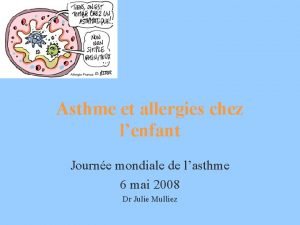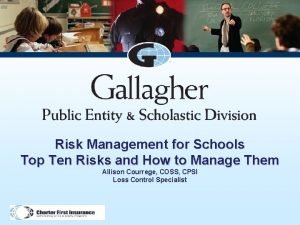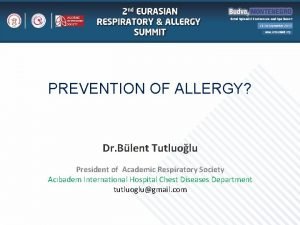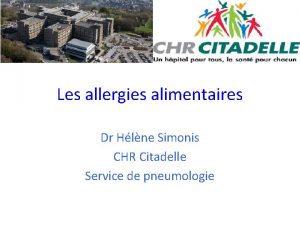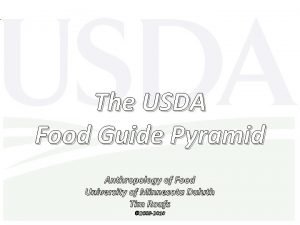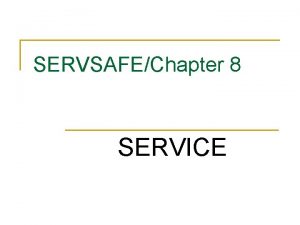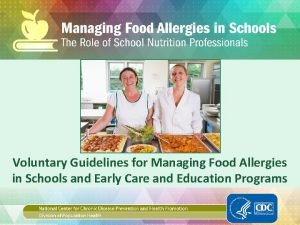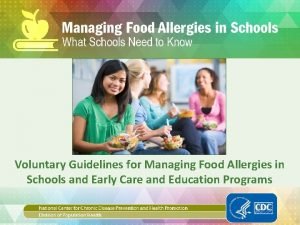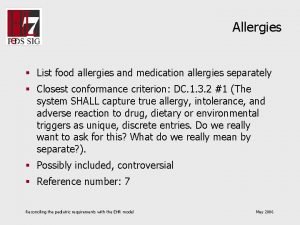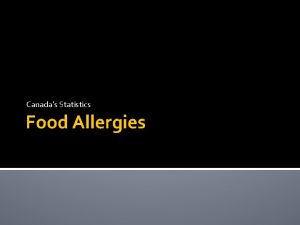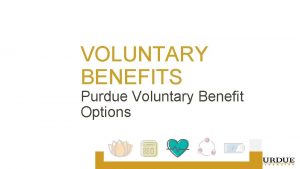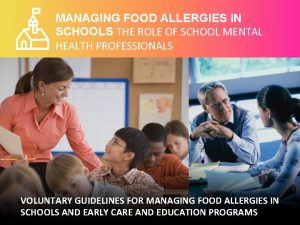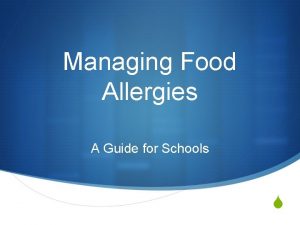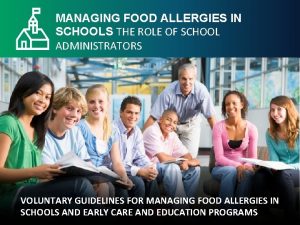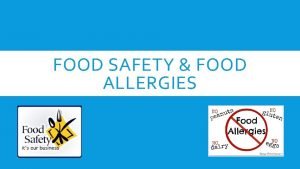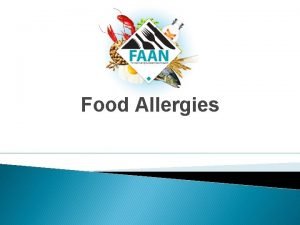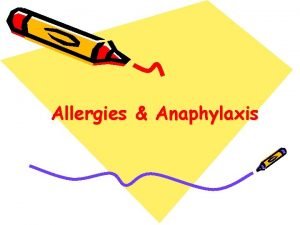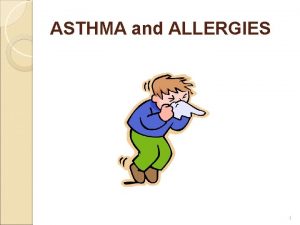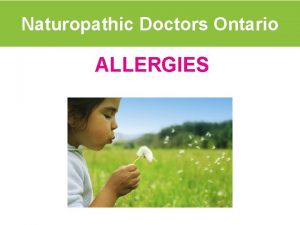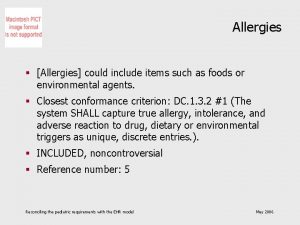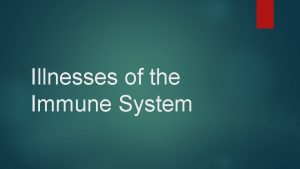Voluntary Guidelines for Managing Food Allergies in Schools





















- Slides: 21

Voluntary Guidelines for Managing Food Allergies in Schools and Early Care and Education Programs

Objectives Describe the symptoms of food allergies and life-threatening reactions. Identify three actions administrators can take to support the management of food allergies in schools. Identify two resources that can be used to support the development of healthy and safe schools for students with food allergies. 2

Overview These guidelines can help schools manage the risk of food allergies and severe allergic reactions in students. Managing food allergies requires a partnership between families, health care providers, and schools. 3

Did you know ? 4% of students are affected by food allergies, and the incidence is increasing. 1 in 5 students with food allergies will have a reaction while at school. 25% of severe food allergy reactions at school happen to students with no previous known food allergy. 4

Did you know ? A food allergy is an adverse immune system reaction that occurs soon after exposure to a certain food. Food allergy symptoms can include multiple organ systems including, respiratory, gastrointestinal tract, skin, cardiovascular, and neurological. A severe life-threatening allergic reaction is called anaphylaxis. 5

What can you do? If you suspect anaphylaxis, do the following: 1. Activate the student’s food allergy emergency plan. 2. Be ready to administer an epinephrine autoinjector if you are delegated and trained to do so. 3. Call 911 or the emergency medical system immediately. All students with anaphylaxis must be monitored closely and evaluated as soon as possible in an emergency care setting. 6

Important Anaphylaxis Response All students with anaphylaxis must be monitored closely and transported by ambulance for evaluation as soon as possible in an emergency care setting. 7

What can you do? Lead your school’s planning for managing food allergies n Coordinate planning and implementation of your school’s Food Allergy Management and Prevention Plan (FAMPP). n Identify a team leader. 8

Food Allergy Management and Prevention Plan Priorities 1. Ensure the daily management of food allergies for individual children. 2. Prepare for food allergy emergencies. 3. Provide professional development on food allergies for staff members. 4. Educate all students and their family members about food allergies. 5. Create and maintain a healthy and safe educational environment. 9

What can you do? Support professional development on food allergies for school staff: n Provide training for all school staff. n Ensure staff understands the school’s legal responsibilities under federal law. n Communicate district policies and school’s plan to all school staff, volunteers and families. 10

What can you do? Oversee the daily management of food allergies for students n Ensure implementation of district food allergy policies, school Food Allergy Management and Prevention Plan, and student emergency care plans. n Arrange appropriate accommodations for students with 504 and IDEA eligible services. n Ensure exchange of information occurs on a need to know basis in accordance with FERPA and other confidentiality laws. 11

What can you do? n n Support practices that protect and promote the health of students with food allergies across the school environment. Ensure that students with food allergies have an equal opportunity to participate in all school activities and events. 12

What can you do? Prepare your school to be ready to respond to food allergy emergencies: n Ensure that responding to food allergy emergencies is a part of your school’s emergency plan. n Set up an easy-to-use communication system for staff who may need to respond to food allergy reactions and emergencies. 13

What can you do? n Communicate food allergy management and policies to parents and families. n Ensure that staff who are trained and delegated to administer epinephrine autoinjectors can get to them quickly and easily. n Plan and prepare for field trips. n Practice responding to food allergy emergencies with emergency response drills. 14

Steps to Take Within 24 Hours of a Nonfatal Food Allergy Reaction ü Call parent or guardian to follow up on student condition. ü Review anaphylactic or allergic episode with parent or guardian and student. ü Discuss family role with parent or guardian to improve outcomes. ü Discuss school and home concerns to improve prevention, response and student outcomes. ü Ask parent or guardian to replace the epinephrine dose that was given, if needed. ü Ask parent or guardian to follow up with health care provider. Source: National Association of School Nurses, 2011 15

What can you do? Take the lead to create and maintain a healthy school environment: n Establish policies that address competitive foods. n Teach children, parents, and families about food allergies. n Enforce school rules that prohibit discrimination and bullying. 16

What can you do? Know your legal responsibilities n Laws that prohibit discrimination on the basis of disability. t Section 504 of the Rehabilitation Act of 1973. t Americans with Disabilities Act of 1990. t Individuals with Disabilities Education Act (IDEA). Richard B. Russell National School Lunch Act. n Family Educational Rights and Privacy Act of 1974 (FERPA). n 17

Where can you find more information? Voluntary Guidelines for Managing Food Allergies in Schools and Early Care and Education Programs. Available at www. cdc. gov/healthyyouth/foodallergies/ Food Allergy Resource and Education (FARE). Available at http: //www. foodallergy. org/resources/schools National Association of School Nurse (NASN), Food Allergy and Anaphylaxis Tool Kit. Available at http: //www. nasn. org/Tools. Resources/Food. Allergyand. Anaphyla xis National School Boards Association, Safe at School and Ready to Learn Policy Guide. Available at http: //www. nsba. org/services/school-board-leadershipservices/food-allergiesschool-health 18

Questions ? 19

Thank You 20

References 1. Branum AM, Lukacs SL. Food allergy among U. S. children: trends in prevalence and hospitalizations. NCHS Data Brief. 2008; 10: 1 -8. 2. Liu AH, Jaramillo R, Sicherer SH, et al. National prevalence and risk factors for food allergy and relationship to asthma: results from the National Health and Nutrition Examination Survey 2005 -2006. J Allergy Clin Immunol. 2010; 126(4): 798 -806. e 13. 3. Mc. Intyre CL, Sheetz AH, Carroll CR, Young MC. Administration of epinephrine for lifethreatening allergic reactions in school settings. Pediatrics. 2005; 116(5): 1134 -1140. 4. Sicherer SH, Furlong TJ, De. Simone J, Sampson HA. The US Peanut and Tree Nut Allergy Registry: characteristics of reactions in schools and day care. J Pediatr. 2001; 138(4): 560565. 5. Nowak-Wegrzyn A, Conover-Walker MK, Wood RA. Food-allergic reactions in schools and preschools. Arch Pediatr Adolesc Med. 2001; 155(7): 790 -795. 6. Boyce JA, Assa’ad A, Burks AW, et al; NIAID-Sponsored Expert Panel. Guidelines for the diagnosis and management of food allergy in the United States: report of the NIAIDsponsored expert panel. J Allergy Clin Immunol. 2010; 126(suppl 6): S 1 -S 58. 21
 Imperfectly voluntary act example
Imperfectly voluntary act example Food allergies and arthritis
Food allergies and arthritis Arthritis and food allergies
Arthritis and food allergies Managing risks in schools
Managing risks in schools Huntsville city schools powerschool login
Huntsville city schools powerschool login Reach target safety
Reach target safety Icd 10 ild
Icd 10 ild Beta glucan allergies
Beta glucan allergies Docteur simonis citadelle
Docteur simonis citadelle Unit 2 food food food
Unit 2 food food food Eltonian pyramid
Eltonian pyramid Food group pyramid
Food group pyramid Guidelines for holding food
Guidelines for holding food Unit 3 lesson 3 guidelines for eating
Unit 3 lesson 3 guidelines for eating Food and beverage operation cycle
Food and beverage operation cycle Formuö
Formuö Novell typiska drag
Novell typiska drag Nationell inriktning för artificiell intelligens
Nationell inriktning för artificiell intelligens Ekologiskt fotavtryck
Ekologiskt fotavtryck Shingelfrisyren
Shingelfrisyren En lathund för arbete med kontinuitetshantering
En lathund för arbete med kontinuitetshantering Särskild löneskatt för pensionskostnader
Särskild löneskatt för pensionskostnader

